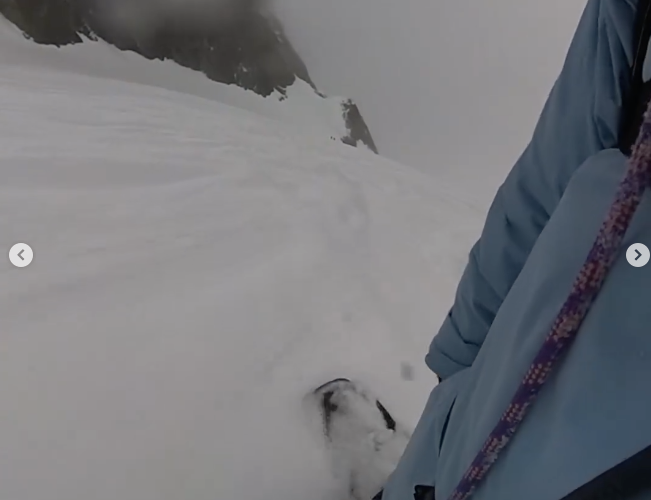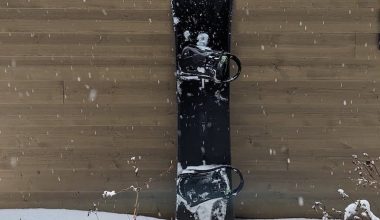So you made plans for a big trip with your friends to Chamonix. Congrats! I’ll tell you right now, it’ll be epic! You guys also planned to do Vallée Blanche. Well I’ll tell you right now too, that’ll be an experience of a lifetime! It’s a backcountry adventure though so there’s definitely more to it. Most importantly, there is the safety aspect that you have to consider.
This article is to give you important points on how to prepare before your Vallée Blanche run from a first-timer-to-Chamonix-and-Vallée-Blanche snowboarder. It’s pretty much the same thing for skiers. It’s the same instruction. We snowboarders just need to consider more things lol
Table of Contents
My experience
Just so you know the basis and where I’m writing from:
— First time in Chamonix, and to Vallée Blanche
— First time doing backcountry actually
— Can handle any groomed/thin layer of snow runs (ugh, east coasters right)
— Can handle any trail colours: green, blue, red (yes, in Europe there’s red: it’s basically like NA’s blue), black, dbl black. It’s just a matter of how long and how tired am I going to be at the end of the run lol
— Can handle small layers of pow (think pow days in east coast) but not proper backcountry powder
— Snowboarder
That said, let’s go through the important points!
Book a guide AHEAD
This is highly, highly recommended. This is not just me but rather Chamonix and the guide companies in the area highly recommend this. Why? It’s backcountry and Vallée Blanche is on a glacier. That means you are at risk of avalanches (which for sure occurs) AND more importantly, crevasses. You WILL see crevasses especially from the mid-bottom of the run of different sizes, so definitely don’t sleep on this. I personally think there’s more risk of crevasses in this region of the world (also given there isn’t much snowfall) so respecc the mountain.
We hired a guide from COMPAGNIE DES GUIDES DE CHAMONIX.
First time doing backcountry?
You regularly do backcountry but first time in Vallée Blanche?
Answer to both: Just hire a guide. Highly recommend.
Equipments you need
Transceiver
You know, just in case you get buried or fall in a crevasse, no biggie.
Included if you hire a guide.
Harness
Yup, it’s the same type of climbing harness you use when you’re bouldering/rope climbing. You’ll want this if you fall into a crevasse :/
You also need this because as you’re hiking down from the top (discussed below), you and your group are tied together as you hike down.
Included if you hire a guide.
Crampons
It’s the spikes addon that you put under your ski/snowboard boots.
Not included but required.
“Ok, but how necessary is this crampons…”
When you get to the top, there’s a ridge where you’ll have to hike down (that’s why you need this and a backpack actually) for bit until you get to the flat part where everyone can strap and un/pack things. It’s the only way down.
The snow’s loose and powdery too. So just imagine you’re walking DOWN an incline, it’s powder, it’s loose, it’ll definitely give easy if you don’t have crampons. There are parts where it’s knee deep. We got “lucky” because it snowed overnight so it was powdery but of course, the purpose of the crampons too is also for ice layers. Just trust me, you need this. At first I thought “pff, this is extra”. As I was (nervously) walking down, “THANK GOD I GOT IT”.
Backpack
More specifically, you need a backpack where you can strap your skis/snowboard as you walk through snow. No one cares how big/small it is or what’s inside. The important thing is you can strap your skis/snowboard on it.
There will be a section where you’ll need this.
Not included but required.
I’ve explained under Crampons (above) why it’s necessary too.
You’ll need your hands free. For skiers, they’re using their poles to hike down. My friends had their skis tied in an “A frame”.
For us snowboarders, you can’t possibly hold it while hiking down. Even if you could, would you risk your lovely board when in one wrong move, that’ll drop ~4000m down and you’ll never see it again?
It was difficult enough already with a backpack because up there it’s naturally windy. So no matter how you do it, your board is acting like a massive sail :/ I strapped mine tight and I was good. But with that, you need to exert pressure against the wind AND maintain your balance AND focus on hiking down safely. One of my hands was holding the “handrail” (read: just a flimsy but reliable rope on the side of the ridge) and the other is the balancing hand and the “just in case I trip” hand. There were some parts I had to hold the rope/snow with both hands.
Btw, when you guys are hiking down, your group is tied together.
Sooo…imagine complicating life by not having a backpack…
Telescopic poles
In the contract and instructions with the guide, it requires specifically “telescopic poles”. They’re basically ski poles that you can compact like a selfie stick.
I know… snowboard and ski poles am i right lol.
“Does it have to be telescopic?”
It is required but after going through it, I don’t know if you need “telescopic” ones per se. I think maybe (don’t quote me on this) you can get away with regular poles. I guess they just want it telescopic for when you need to pack it in your bag like your snowboard when you’re hiking down. But I’m thinking if your board’s sticking out already anyways, what’s a pair of poles right?
I think what the place cares about is that if you (a snowboarder) are on a flat plane, that you’d be able to row out of there.
I did end up using it at least twice. I have no prior knowledge on how to even use poles while riding so it was a figure out at you go. It wasn’t enough to avoid a bad situation but rather making a worst situation to a moderate type of situation.
First time I used it was when we had to traverse sideways (not along the fall line). It was enough to add a bit more speed, but you’re not gonna go from 0 to…any speed lol. It was a dilemma because you know that if you unstrap, the snow’s deep and it’ll be a tiring hike. I would’ve want to just follow the fall line but can’t.
You're only supposed to follow the path of where your guide goes. The guide is basically your minesweeper for crevasses, that's why. There's a +- 5-10 meters on each side and your guide's 9 times out of 10 probably a skier so sometimes it can be challenging for a snowboarder to follow a skier path. I can't just pick up speed with the fall line. I would've needed lots of space.
The other situation was in the expected flat ice part. There’s a tiny decline with it so you can actually ride it out. I was able to ride out 90% of that part. You could ride it out completely if you rode faster, but towards the end if flattens/inclines and I was so tired and it needed some muscle flexing in the parts I was already fatigued.
That part it was easy to unstrap and walk since it’s completely solid ice lol.
Getting the required equipments
How much?
If you don’t have any/all of the equipments, you can get them in town. First when it comes to price, they’re actually very affordable. When I did it for mine, I rented out telescopic poles and crampons. One of them was I think 7€ and the other 11€. So it’s that cheap.
So if you’re like me who thought “maybe I should buy my own gear” before flying to Chamonix”, don’t. You’re just going to use it one time and ~20€ one-time is better than 100s of dollars for something you’ll just use once. It’s only worth it to buy them if you do glaciers a lot. Then again if you do, you’d have your gear already before this point.
Where/how?
You can rent your equipment in town! In Chamonix centre.
So for some who haven’t been there (as I once was), that can be confusing. If you’re used to North America layout, there’s a “ski resort” and there are just small shops around it (but it’s still in the resort).
For Chamonix, or Europe in general, it’s not a privately-owned ski resort per se but rather an actual small town and then the lifts/gondolas just zigzag and spear through town in certain places. That’s why I’m asking you to go to town.
If you want to be more specific, if you use the bus (which I highly recommend, just look for Chamonix Centre / Place Mont-Blanc / Mummery and that’ll drop you in the centre of the town.
Which shop? Any sports shop for sure they have it.
If you ride Burton Step Ons like me, you're gonna have to get a specific type of crampons. It's the old one that you have to strap around your boot instead of the more modern one that just clamps on. I don't see any functional difference there. It's just a different type of fastening. Anyways, I'm just mentioning it because NOT ALL shops carry those. So if you're wearing Step Ons, you might have to bounce around shops. It's the heel clip disrupting in the more modern crampons.
Health and fitness
I’d say this is the most important factor that you have to prepare. This is the one where I lacked, and this is taking into consideration I’ve prepared, worked out, and conditioned myself already before heading there. Well to be fair, it’s not like I did intense workouts.
Anyways, my point is: work out and get your strength and fitness in tip top shape as much as you can. I’m not talking about your snowboard skills and technique and if you can ride switch or do down unweighted turns. It’s more like, can you do a long traverse on your heel edge, holding a carve for a good 3-5mins straight? Can you ride fast while being in perfect control? If so, can you absorb bumps along the way varying from waist to ankle height moguls? Can you do everything that you normally can do but on a wet, heavy pow? If you tumble and fall in pow, can you “swim” out of that, get back on your board with minimal rest because your entire crew is waiting?
Variable terrain
Speaking of variable terrain, you will encounter ALL types of terrain in that run. Maybe if you go Jan/Feb when it’s just cold all over maybe not. We went March and I felt it all.
Pow runs
From the very top of the run, it’s of course plentiful pow pow. Depending on the time of the year too, that may be a little bit slushy or god forbid, icy.
It’ll be tracked out
It’s definitely not your normal piste so there’s less people going through that run, but there will still be lots of people running that run. It will still be tracked out. So can you ride in and out of people’s tracks no problem (plus variable terrain)?
Somewhere towards the middle of the elevation it’ll start to go crust-on-dust (powder underneath but thin layer of ice on top) and then in the mid area, it becomes more packed (still natural snow, but packed/getting heavy).
Flat then ice
At some point there’s this one big almost-flat part and I think that’s as glacier as you can get. It’s not like a skating rink where it’s flat. It’s a naturally-formed ice so it’s uneven, groovy, but not like a mogul. I hope you know how to rock your board from edge to edge. It’s a good relaxation run since you’re just mildly engaging your muscles and you’re alternating. However, it still needs extreme focus. You want to dig those edges but also not skid and shave off some speed (you’ll need as much as you can). You can’t flat base is because it’s uneven and it’ll buck you around. If you catch and edge, well that’ll be a hard slam. Also, it’ll be a loooong walk lol.
It then becomes variable again in a sense where it becomes packed powder again, sometimes thin snow, then ice, then pow, etc.
Ice-ish and narrow and banked
Towards the end it’s basically close-to-ice or very packed snow + banked runs. Obviously everyone’s just heading to the same staircase so it’s funneling to only 1-2 paths to it now.
Skills requirements
Predetermined paths
The most important part in this one is the one we just discussed. It’s so important that it’s stated as a requirement in your contract when you register:
You have to be able to turn (on variable terrains) on a predetermined path.
You know when you’re in your own ski resort, let’s say you do a black trail. Let’s say the main part of that segment is steep and moguly. If you’re on piste, that run is probably wide enough that you can pick and choose another side where there’s little to no moguls or maybe it’s less steep.
If you do Vallée Blanche, you won’t have those options. Sure it’s backcountry and it’s wide open, but remember, you can only go to the path where you guide goes. S/he’s acting as a minesweeper for crevasse for you guys.
At the same time there will legit be parts where there are crevasses both on your left and right side so obviously you can only go this one way in the middle. Don’t worry you’ll have enough width and wiggle room for it, but you can’t go “oh, I’ll choose another path on that side instead”.
Lastly, as mentioned at the bottom, it really becomes predetermined hard. Literally hard, because it’s almost an ice path lol.
General skills gauging
You should be used to black runs(both NA/EU) for sure. At the very least is “very difficult blue (NA) or red (EU) runs”. It’s not like it’s difficult the whole way but there will be segments where that’s the skill level required and you’ll have no way around it.
You should be comfortable with moguls. It’s not like you have to be expert and buttery smooth with it, but at least you should know what to do with it, and how to handle/navigate/go through it.
Again, the health and fitness, can’t stress that enough.
Be able to ride black trails in varying snow conditions.
I wasn’t the most expert in our group but I can confidently say that I can navigate all trail colours and any conditions. It’s just a matter of how slow will I be lol.
You should be able to do varying turn sizes, from tight, small arc turns when it’s steep to wider turns when there’s more space.
You don’t need any park skills here.
Snowboard requirements
I would say directional, freeride boards are definitely preferred. You’d want as much tech to assist with the float. Setback and/or taper def helps. If you’re gonna use a twin board (which I’ve seen a couple of Burton Customs both when I was there and in videos), definitely set it all the waaay back. It’s such a leg burn already for me on shallow pow with my Burton Custom on a small hill. I know the nose is technically longer on that board but it helps just a little. You’ll still shift your weight back somehow and it’ll be a leg burner. So I can’t imagine how that would be better on backcountry, on a 2-4h run.
For boots and bindings, medium-stiff to stiff bindings and boots would be preferred as well. I rode my Burton Rulers and Step Ons (which are technically just medium at best) and it worked admirably but towards the end, it would’ve been nice to have had a slightly stiffer boot so it would help and act as more of a leverage when you’re traversing, trying to hold a toe edge, and driving your knee/weight over your toes. I guess it’s a nice to have. It’s not so much of the response (but I guess it is) but more so as an additional leverage (as in Physics), for you.
I say “preferred” for these, not required btw.
Wrap Up
I hope you find these info useful. There’s lot to wrap up here and I’m sure readers will be more concerned on specific parts of the article so I just hope I’ve given you what you wanted/needed!


